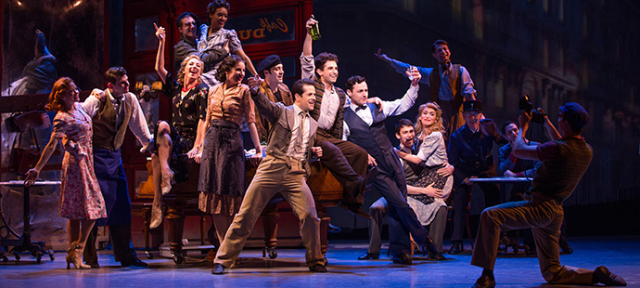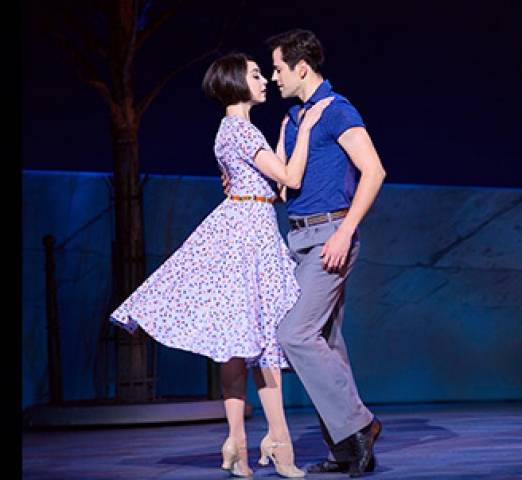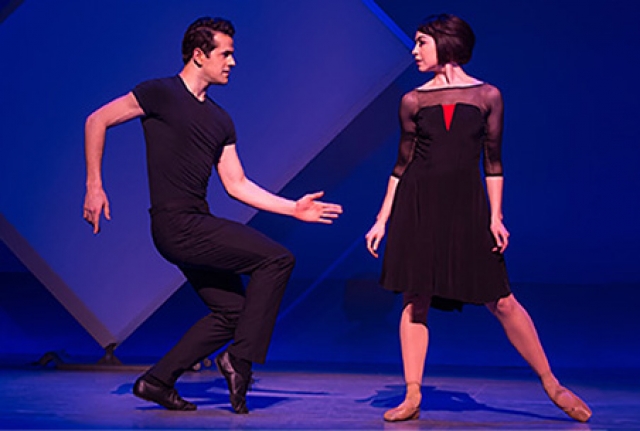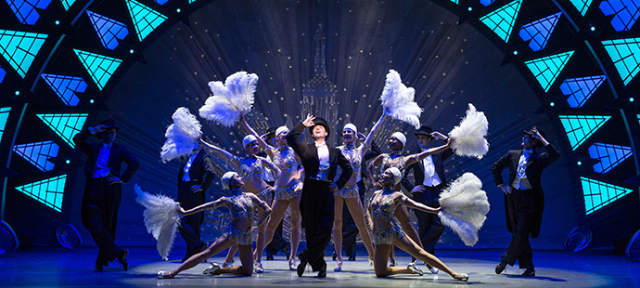An American in Paris
Road Company in Miami
By: Aaron Krause - Dec 29, 2016
Anyone who has seen the musicals “West Side Story” and “Billy Elliot” knows that dance plays an integral role in those shows’ storytelling.
During parts of “West Side Story,” tough, aggressive dance moves mirror the fearless and gritty personalities of the gang members.
In a scene from “Billy Elliot,” the force of the title character’s “Angry Dance” reinforces the frustration and anger of the motherless, misunderstood English lad.
The dancing in “An American in Paris,” as important as in “West Side Story,” expresses a mood of its own.
Freedom, elation and romance are deftly conveyed through dance, dialogue and singing by a splendid cast on a North American tour of the Tony-nominated Broadway musical. The show, which received and was nominated for many accolades, is playing downtown Miami’s Adrienne Arsht Center for the Performing Arts of Miami-Dade County, Inc. through Sunday before heading to theaters north and west.
Thanks to the detail-oriented, sensitive direction and choreography by Christopher Wheeldon, the performers excel in many areas. Dance-wise, they invest each slide, spin, leap and lift of a fellow performer with post-war joy, hope and infectious optimism in Paris after World War II.
“For four years, the City of Lights went dark,” we’re told at the beginning. “How can you feel liberated when your city is crushed?”
That crushed feeling gives way to romantic longing, expertly conveyed through the choreography, creating movement for glorious songs from the Gershwin brothers.
This show is about transformation – from a tattered city to one of pride and physical beauty, from heartache, fear and weariness to newfound buoyancy and an air of love.
“An American in Paris” is in perpetual motion; set pieces move on and off the stage as do people. Change is coming, symbolized in part by swastikas disappearing, replaced by a proudly-flying, towering French flag, bringing to mind the fervor in “Les Miserables.”
In short, from the ashes of a war-torn country, vivacious French life in all its splendor comes alive. That includes breathtaking scenery, costumes and projections that would take pages upon pages to describe in their entirety. Suffice it to say, set and costume designer Bob Crowley and 59 Productions (the projection designer) have created visual displays that will leave you wide-eyed with wonder.
Of course, if you serve up too much of a visual feast, you might drown out the emotions and narrative of a piece. Thankfully, director/choreographer Wheeldon doesn’t allow that to happen.
While the musical is dance-heavy, there’s plenty of dialogue and vocal singing to satisfy most musical theater fans.
The dialogue and those Gershwin gems help tell a story that doesn’t break new ground in the genre of romance.
Jerry Mulligan, an American soldier returning from battle, decides to remain in Paris to pursue his passion of painting. He’s aided by fellow veteran Adam Hochberg, a composer, and Henri Baurel, the son of wealthy industrialists and an inspiring performer. All three imagine a brighter future.
Mulligan’s heart is immediately captured by a beautiful French ballerina named Lise Dassin. But in order to get the girl, Mulligan will have to overcome obstacles – including a revelation that pits dutiful, involuntary love against sincere, passionate love from the heart and soul. Mulligan doesn’t like to fight, but he’ll have to battle for his girl.
The rather thin story brings together something larger than a love triangle; more like a romantic square or other multi-shaped object; there are more than three individuals entangled in the battle for love, of which Dassin is at the center.
If you’ve seen the new movie musical “La La Land,” (with lyrics by the young and renown team of Benj Pasek and Justin Paul) you’ll appreciate that the eye-popping visuals in that movie are as glorious as those in this production.
“La La Land” centers on the romance between an actress and a jazz pianist. Fittingly, the music in “An American in Paris” is by siblings George and Ira Gershwin, who’ve become synonymous with the sounds and style of the jazz age.
“An American in Paris” is a musical composition by George Gershwin, which he referred to as an “extended symphonic tone poem.” The New York Philharmonic commissioned it and the piece soon became one of his most famous compositions. It was inspired by his visit to Paris during the 1920s.
The composition premiered on Dec. 13, 1928 at Carnegie Hall and inspired the famous 1951 Academy Award-winning movie of the same title starring Gene Kelly and Leslie Caron. The musical is inspired by the beloved film.
The transformation from compositional piece to musical came after producer Arthur Freed attended a concert featuring the composition. Freed built a musical featuring Gershwin tunes following months of negotiations with Ira Gershwin, estate trustees and music publishers.
The Gershwins composed the music for other shows; the joyous “I Got Rhythm,” for example, is included in “Crazy for You,” a Gershwin brothers’ musical comedy that won the 1992 Tony Award for Best Musical.
The song “An American in Paris,” sung with infectious vivacity by the company, helps the show dive into romance with lyrics such as:
I got daisies
In green pastures
I got my man
Who can ask for anything more?
The musical melds song, story and dance seamlessly into a thematically unified whole. Crowley’s luxurious sets match the music’s elegance, as do 59 Productions sublime projections. The sets, music and projections, in turn, reinforce the beauty of Paris, as do Crowley’s luxurious costumes.
Not all of the scenes in the show are realistic, and lighting designer Natasha Katz’s varied work reinforces this and enhances mood.
Mulligan and Company sing with expression, power and versatility accompanied by a vibrant live orchestra.
Garen Scribner played Mulligan during the reviewed performance on opening night. Ryan Steele plays him on Saturday matinees and Sunday evenings.
Scribner spins like a seasoned ballerina, slides across surfaces with the ease and carefree aura of a child out of school during summer, leaps as though it were as natural to him as a deer and, seemingly without effort but with great devotion, lifts and carries Mulligan’s love, the beautiful Dassin.
Scribner exudes charm, charisma, playfulness, superb athleticism and stage presence in the role. Mulligan also has a pleasant singing voice. He and Sara Esty as Dassin convey touching chemistry.
Esty, who alternates the role with Leigh-Ann Esty, invests Dassin with an understated elegance, sweetness, dignity and sensitivity. She also conveys the character’s guarded nature; this is a woman who spent time hiding during the Nazi occupation of France. In the beginning, Sara Esty has a Marian the Librarian-like wariness, which she aims at Mulligan. However, she makes the character gradually and seamlessly warm up to him. When she does, Esty’s Dassin is a delicate beauty.
Nick Spangler portrays Henri Baurel, a Frenchman, scion of a wealthy Parisian family. Spangler, whose marriage to Dassin was arranged by his strict parents, is self-assured with a strong sense of purpose.
The woman exuding control over him is his mother, Madame Baurel, played with a commanding presence, propriety and fierce pride by Gayton Scott. Think a more hyper, high-strung Judi Dench, and you get an inner picture of Scott’s performance.
Etai Benson has a self-deprecating air and longing for romance as Adam Hochberg, a New York City native who stays in Paris to study composition. Hochberg, the show’s narrator, was wounded during the war, and Benson walks with a convincing limp.
Hochberg soulfully and sadly sings “But Not For Me,” during which he’s resorting almost to self-pity for his lack of success in romance.
More confident is Milo Davenport, an heiress to a fortune and a benefactor to the Parisian arts. Davenport’s played with glamor and outward self-assuredness by Emily Ferranti. The character tries to curry favor with men with a charming smile that communicates a sense of pushiness. The character changes for the better, however, when she learns people cannot buy love. Ferranti eloquently undergoes this change, making the character easier to pull for.
The supporting cast sings, dances and acts with equal verve, contributing immensely to the show’s energy.
“An American in Paris’ elegance, wit and smarts will enchant you.
The varied score, ranging from the electric “I Got Rhythm” to the tender “They Can’t Take That Away From Me,” will sweep you off your feet.
Perhaps the show will even take away your two left feet.
“An American in Paris” finishes its run in Miami on January 1. For information on times and tickets, visit www.arshtcenter.org. For more information about venues, times, dates and ticket prices on the national tour, visit www.anamericaninparisbroadway.com




